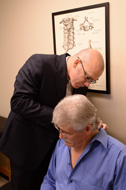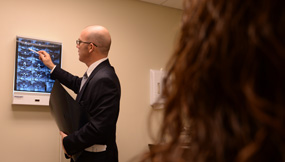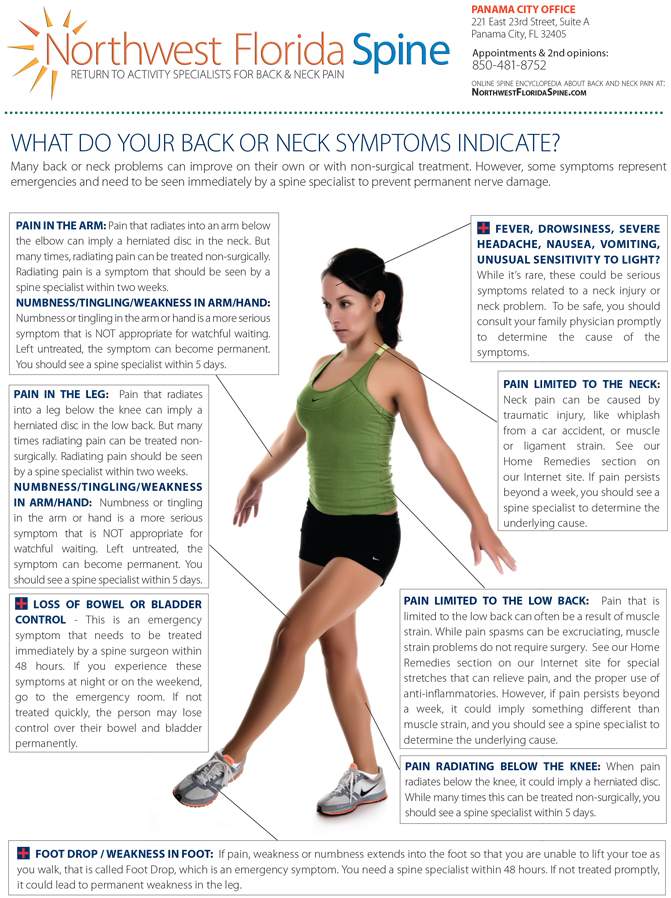Neck pain
Overview | Causes | Symptoms | Diagnosis | Treatment | FAQ
Overview
Like back strain, neck strain is an irritation to tendons, muscles
and ligaments in the upper back and neck area. Whiplash is characterized
by a collection of symptoms that occur following damage to the neck, usually
because of sudden extension and flexion, such as in a car accident.
[top]
Causes
Sometimes neck strain can be brought on by an abrupt movement by the neck,
such as whiplash.
[top]
Symptoms 
Symptoms such as neck pain may be present directly after the injury or
may be delayed for several days. In addition to neck pain, other symptoms
may include neck stiffness, injuries to the muscles and ligaments (myofascial
injuries), headache, dizziness, abnormal sensations such as burning or
prickling (paresthesias), or shoulder or back pain. In addition, some
people experience cognitive, somatic, or psychological conditions such
as memory loss, concentration impairment, nervousness/irritability, sleep
disturbances, fatigue or depression.
[top]
Diagnosis
Outlined below are some of the diagnostic tools that your physician may use to gain insight into your condition and determine the best treatment plan for your condition.
- Medical history: Conducting a detailed medical history helps the doctor better understand the possible causes of your back and neck pain which can help outline the most appropriate treatment.
- Physical exam: During the physical exam, your physician will try to pinpoint the source of pain. Simple tests for flexibility and muscle strength may also be conducted.
- X-rays are usually the first step in diagnostic testing methods. X-rays show bones and the space between bones. They are of limited value, however, since they do not show muscles and ligaments.
- MRI (magnetic resonance imaging) uses a magnetic field and radio waves to generate highly detailed pictures of the inside of your body. Since X-rays only show bones, MRIs are needed to visualize soft tissues like discs in the spine. This type of imaging is very safe and usually pain-free.
- CT scan/myelogram: A CT scan is similar to an MRI in
that it provides diagnostic information about the internal structures
of the spine. A myelogram is used to diagnose a bulging disc, tumor,
or changes in the bones surrounding the spinal cord or nerves. A local
anesthetic is injected into the low back to numb the area. A lumbar
puncture (spinal tap) is then performed. A dye is injected into the
spinal canal to reveal where problems lie.

- Electrodiagnostics: Electrical testing of the nerves and spinal cord may be performed as part of a diagnostic workup. These tests, called electromyography (EMG) or somato sensory evoked potentials (SSEP), assist your doctor in understanding how your nerves or spinal cord are affected by your condition.
- Bone scan: Bone imaging is used to detect infection, malignancy, fractures and arthritis in any part of the skeleton. Bone scans are also used for finding lesions for biopsy or excision.
- Discography is used to determine the internal structure of a disc. It is performed by using a local anesthetic and injecting a dye into the disc under X-ray guidance. An X-ray and CT scan are performed to view the disc composition to determine if its structure is normal or abnormal. In addition to the disc appearance, your doctor will note any pain associated with this injection. The benefit of a discogram is that it enables the physician to confirm the disc level that is causing your pain. This ensures that surgery will be more successful and reduces the risk of operating on the wrong disc.
- Injections: Pain-relieving injections can relieve back pain and give the physician important information about your problem, as well as provide a bridge therapy.
[top]
Treatment
Treatment for individuals with neck strain may include pain medications, nonsteroidal anti-inflammatory drugs, antidepressants, muscle relaxants, and a cervical collar (usually worn for two to three weeks). Range of motion exercises, physical therapy, and cervical traction may also be prescribed. Supplemental heat application may relieve muscle tension.
Generally, prognosis for individuals with neck strain is
good. The pain clears within a few days or weeks. Most patients recover
within 3 months after the injury, however, some may continue to have residual
neck pain and headaches.
[top]
FAQs
When is neck strain serious?
As with back pain, any time symptoms do not improve after three days, it's a good idea to see a spine specialist. Also, red flag symptoms like pain or numbness radiating into an arm, especially down into the fingers, are emergency symptoms and should be seen by a spine specialist within 48 hours, or you risk permanent damage.
See our exercise library for helpful neck exercises.
How can I prevent neck strain?
You can minimize your risk of experiencing neck strain by strengthening
the muscles and ligaments in your neck, avoiding contact sports, and driving
cautiously.
[top]
Home Remedy Book

As a community service, Northwest Florida Spine mails out a free 36-page Home Remedy Book with customized stretches that can relieve some back and neck pain symptoms. Enter your name and address and we will mail you a copy.
Back to Life Journal

Download our free 16-page Back to Life Journal that shows how to get back to golf, tennis, hiking and more with home remedies. Insert your email to subscribe and download.
Symptoms Chart
Some symptoms can become permanent if you don’t see the physician with in 24 hours. Find out when you can use “watchful waiting” and when you have an emergency symptom.
Exercise Library

What do exercises have to do with relieving pain? Research in sports medicine and spine care exercises have shown to help relieve joint, ligament, muscle problems in the legs, arms, neck and back and increase range of motion.
Need an Appointment?
Dr. Michael Rohan, Jr. is a board certified orthopedic surgeon who is fellowship-trained in spine surgery, the highest level of medical education in the U.S. For over 10 years, Dr. Michael Rohan, Jr. had a prominent spine center on the Florida Gulf Coast with offices in Panama City and Destin before expanding his practice with a new spine care location in Middleburg in Clay County, Florida, a suburb of Jacksonville in Northern Florida. The Jacksonville practice location is convenient to patients from other cities like St. Augustine, Gainesville, Palm Coast, Daytona Beach, and Duval County. Other patients travel from South Georgia cities like Brunswick, GA; Waycross, GA; and coastal locations like Jekyll Island and Savannah. If you’ve been told you need spine surgery, it can be beneficial to get a second opinion for spine surgery from a spine surgeon who specializes in minimally invasive spine surgery and artificial disc replacement.
Disclaimer: Internet Explorer is now obsolete and has been replaced by Microsoft. If you are viewing in Internet Explorer 8 or older, you will need to update your browser by Clicking here.

